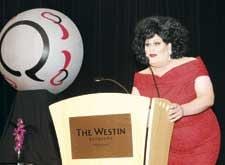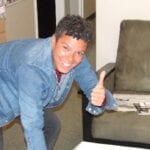When young people walk down Davie St in their “hot pink tank tops and their hot pink go-go shorts, holding hands with their boyfriend or girlfriend with the hot pink hair,” they should know that it’s the Pierres, the Janines, the Teds and the Marks that made it possible for them to do so, says Joan-E (aka Robert Kaiser), the first inductee into Canada’s Q Hall of Fame.
Joan-E, along with late Prime Minister Pierre Trudeau, Little Sister’s manager Janine Fuller, Dogwood Monarchist Society founder ted northe and Olympic gold medalist Mark Tewksbury, were the inaugural inductees into the hall of fame launched at the QBall held at the Westin Bayshore Hotel, Sep 19.
About 150 people attended the black tie event that struck both humorous and sombre notes and was emceed by drag artist Symone who did a rousing Patti Labelle interpretation of gay anthem “Somewhere Over The Rainbow” to open the evening. She then morphed into Diana Ross’ signature number “Reach Out And Touch Somebody’s Hand” before exchanging an evening gown replete with dangerous high heels for roller blades to do Rose Royce’s “Car Wash.”
But it was Joan-E’s acceptance speech — taking a page from late night talk show host David Letterman’s Top Ten List — that had the audience both in stitches and reflective.
On the serious side, she paid homage to the many drag queens who have “gone too soon and will never stand up here and receive the award for lifetime achievement in person — and that is a shame.”
She also rued the still elusive cure for AIDS and what she termed “the bridge too far” that cleaves the gay and lesbian communities.
“Why does a community that consistently has to fight for its rights and its lives continue to weaken itself by standing in groups of twos, threes, twelves in difference and in divisiveness?” she asked. “I’ve always thought — and I borrow this slogan — that united we stand, divided they’ll pick us off one by one.”
On the lighter side, Joan-E noted that she “never met a cute boy, a beer or buffet” she didn’t like and, to the laughing gasps of the crowd, very gamely informed Tewksbury that as long as she had a deep end, “you have a place to practice your strokes.”
“You never should have put me first,” Joan-E, without batting a well-groomed eyelash, coyly told ball organizers more than once.
Like Joan-E, Fuller spoke to the importance of the queer community coming together to meet the challenges that still have to be fought. Standing behind Little Sister’s counter every day, Fuller said she witnesses the toll that the continuing cycle of violence visits on the community.
“Because I’m at the bookstore and I’m at the cash, I see everyone who’s being beaten up or who’s going through the violence, or reflecting on the violence later,” Fuller noted. “It has such a strong, unbelievable impact on us and who we are as queer people.”
She referred to the attack on Ritchie Dowrey at the Fountainhead Pub six months ago, from which he has not “in any way recovered.”
“I think we have to remember him today — every day,” Fuller said.
For his part, keynote speaker Patrick O’Reilly of the Winnipeg-based Canadian Museum of Human Rights warned of the need to remain vigilant despite achievements like the decriminalization of homosexuality.
“Each of us has an individual responsibility to do what we can to ensure that our rights continue to be upheld, and it’s our responsibility as Canadians to continue to speak out and to ensure our LGBT voices are heard.”
“I think the evening went really well,” Q Hall of Fame chair and founder Paul Therien said.
“We had a very short lead-in time to it,” he added, noting that “we had five months to plan this.”
Therien admitted he was hoping for a bigger turnout in the 200 to 250-person range and cited the short planning timeframe and the late launch of the marketing campaign as reasons for the low attendance.
“Obviously the less people that turn out, the less money that comes in. We will have to look at that,” he said. “In Vancouver, there’s not a lot of black tie events like this in the queer community, so it’s new. We didn’t get the word out as quickly as we could [have].
“Next year, I think we’ll see a better turnout honestly because we have the word out, we’re getting the word out,” predicted Therien, who said marketing for next year’s event, also to be held in Vancouver, has already begun.
This year’s ball proceeds go to Qmunity (formerly The Centre). Qmunity will also receive a caretaker fee for housing the physical hall of fame containing inductee biographies and photographs.


 Why you can trust Xtra
Why you can trust Xtra


